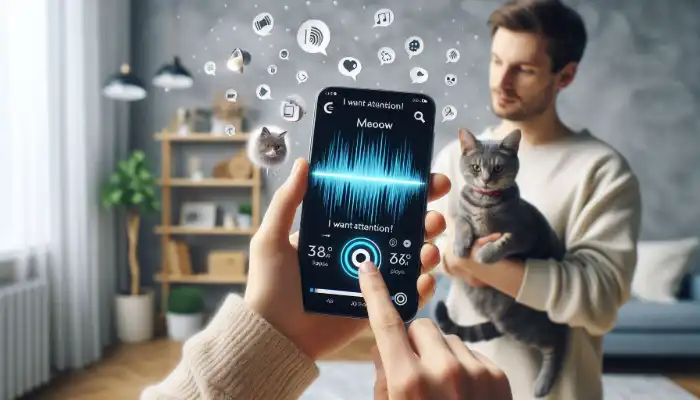Cat language translator tools have gained popularity among cat owners eager to understand their feline companions better. These translators claim to decode a cat’s vocalizations—such as meows, purrs, and chirps—into human language using AI and machine learning.
From mobile apps to wearable devices, various tools attempt to bridge the communication gap between humans and cats. However, their accuracy remains debatable, as feline communication is highly context-dependent. This article explores how these feline sounds translators work, their effectiveness, and whether they truly enhance human-cat interactions.

Cat Language Translator: What Is It?
A cat language translator allows users to discern a cat’s vocalized or behavioral actions. Cat translator often claim to convert cat purring or other sounds into an understandable human dialect. These tools have become popular among cat owners who wish to better connect with their furry companions.
Types of Cat Translators
There are various types of cat language translator online, from mobile apps to AI-powered tools, each designed to interpret feline communication differently.
- Mobile Apps – Apps like MeowTalk that analyze cat sounds through AI.
- Sound Analyzers – Tools that capture the nuances of several cat meows and attempt to associate them with probable meanings.
- Cat Language Translator Online Tools – Uploading cat sounds is allowed for analysis on web-based platforms.
- Wearable Devices – Experimental devices that translate speech by attaching a microphone to the cat’s collar.
Why Do People Use Cat Translators?
People use the cat translator app to understand their feline companions better, interpret their meows and body language, and strengthen their bond through improved communication.
- To interpret more advanced forms of their cat’s meows, which indicate hunger or discomfort, along with affection.
- As a pastime, since many pet owners love using apps that translate phrases.
- To improve pet ownership, by utilizing a more proactive approach toward feline communication.
There is no question that cat language translators have become popular tools, although their effectiveness continues to be dragged into debates. Knowing how these tools function can help in managing expectations appropriately.

How Do Cat Translators Work?
Human to cat translators, they use tools such as AI, machine learning, and sound pattern recognition to transform feline languages into human languages, an English to cat translator. Cat stated that one of such tools, attempts to understand the connotations of various feline sounds, including meowing, purring, and chirping, by conducting data analysis on the recordings of different cats.
Key Mechanisms Behind Cat Translators
| Method | How It Works |
|---|---|
| Sound Recognition | Distinguishing sounds in cat vocalizations. |
| Machine Learning | Listening to recorded meows and looking them up in a catalog of wild sounds. |
| Pre-Set Phrases | Able to provide answers via a variety of common cat sounds such as “hungry” or “playful.” |
| Body Language Analysis | Some of them attempt to interpret the position of the tail, the position of the ears, as well as posture. |
Breaking Down the Translation Process
- Recording the Cat’s Sound – The tool picks up the sound made by the animal.
- Analyzing the Frequency and Tone – The sound conforms to the established feline communication patterns.
- Matching with a Database – The sound is sorted into categories based on the translation done.
- Providing a Human Interpretable Translation – A human-interpretable meaning is then outputted.
Despite how promising these AI tools seem to be, the AI translations frequently raise eyebrows over whether they are indeed accurate.

Can We Translate Cat Language?
Before trusting a cat language translator, the most vital question to ask is, do cats have a defined structure to their speech like humans? Cat speech is highly context-based, as instinctive as it is, and does not revolve around the human language structure of grammar and syntax.
How Do Cats Communicate?
Cats possess numerous ways they can vocalize as well as express their feelings in a non-vocal manner. Capable of:
Vocalization
- Meows: These are primarily used when interacting with humans instead of other cats.
- Purrs: Most of the time, they show signs of comfort but may also indicate distress.
- Chirps and Trills: Commonly utilized by mother cats when calling their kittens or showing signs of excitement.
Body Language
You communicate with your cat through your body, and it can be separated into two distinct features. Over the years, a cat’s tail can easily be moved in various directions while being flicked, showing signs of irritation, or rested aloft to display cynicism.
- Tail Movements: A raised tail signals friendliness, while a flicking tail indicates irritation.
- Eye Contact: Slow blinking is a sign of trust and affection.
Is There a Way to Translate Cat Sounds?
As is the case with other mammals, there exists no universal form for cat verbalizations. The meow sound does not have a single counterpart, as any cat can use it when hungry, tired, or even ready to mate.
If you’ve ever wondered what your cat is trying to say, it’s time to learn how to speak cat translator and decode their sounds.
For this reason, knowing the unique tongue of the cat needs careful observation and interaction over a long period.
Cat Language Translators: Are They Accurate?
The concern that most cat owners have is whether the cat language translator can analyze the sounds their pet makes. While these devices are built on sophisticated AI technology, the precision of their results will depend on multiple factors.
Factors Affecting Translation Accuracy
- Differences Between Individual Cats – Cats differ from each other when it comes to how they vocalize, complicating the idea of universal translations.
- Limited Data – AI models are trained and designed with existing datasets, which means there might not be a comprehensive dataset that covers all types of cat meows.
- Context Matters – Meow is not a universal word, and the context in which it is applied will change as per various factors such as tone, body language, and environment.
Scientific Studies on Cat Translation
A few studies have focused on cat utterances and their meanings:
- One study conducted by animal behaviorists showed that cats only meow to humans, but never to other cats.
- Research shows that cats have a specially trained voice that knows exactly when to meow to their owner, which also implies that a cat language translator is not likely to work for all cats.
Real-World Effectiveness
Overall, users have highlighted a variety of results from using these cat language translator applications. Some of them:
- Some say that the translation correlates with their cat’s actions, such as “I’m hungry” whenever food is brought to the cat’s bowl.
- Others find the results nonsensical, or at best, random.
Are These Translators Trustworthy?
Cat meow translator can be fun and engaging, but their accuracy varies, as feline communication is complex and not fully understood by technology.
Cat language translators can provide entertaining glimpses, but they shouldn’t be relied upon too heavily and should not stop a person from watching, listening, and analyzing a cat’s body and verbal communication.
Cat Language Translator Apps & Devices
The range of tools that can help cat owners interpret their pet’s vocalizations is increasing with advancements in technology. With different types of apps and device options available, many claim to translate cats’ meows and assist in enabling communication between humans and cats. Below are some of the most common choices.
Most Popular Cat Language Translator Apps
| App Name | Features | Pros | Cons |
|---|---|---|---|
| MeowTalk | AI-powered meow identification, customizable cat profiles | Learns from your cat, customizable | Varies in accuracy, only effective when used frequently |
| Human-to-Cat Translator | Can use pre-recorded sounds of cats and respond in a playful way | Fun and entertaining | Lacks valid scientific proof |
| Cat Translator Simulator | A basic soundboard featuring common sounds made by a cat | Very user-friendly, ideal for children | No AI or real translation ability |
Best Tools for Cats’ Communication Translations
- Pet Sound Analyzers – Machines that perceive and interpret cat sounds.
- Wearable AI Collars – Some prototypes are meant to convert cat feelings into text.
- Smartphone Apps with AI Learning – Applications that adjust to different cats’ sounds for enhanced precision.
Even though these tools can be entertaining and useful at times, they cannot substitute for an understanding of cat behavior.
Other Ways to Understand Your Cat
Feline proprietors can comprehend their pets’ emotional interactions without the use of a cat language translator online. Some of the natural methods of interpreting cat interactions include observations:
1. Pay Attention to their Meows
- Short, high-pitched meows – Often used close to an owner or used as a simple hello.
- Loud, drawn-out meows – Frequently associated with vocal cat food calling, or cat food irritations in humans.
- Low growls or hissing – Directions of fear and territorial danger signals.
2. Pay Attention to their Body Movements
- Tail upright with a slight curve – A sign of a happy, friendly cat.
- Ears flattened backward – Signs of aggressive gestures or irritation.
- Slow blinking – A form of opening and closing their eyes, symbolizing showing care.
3. Non-Voice Actions to Watch Out For
- Kneading with paws – Often observed in an affectionate cat rubbing in the pretense of fighting.
- Rubbing against you – Used as a claim to designate part of the space as theirs.
- Licking or gentle biting – Gentle nibbles or licks are used normally towards someone they like.
Your relationship with your cat can be more meaningful and your communication simpler with these techniques, particularly when used together with a cat language translator online.
Are Cat Translators Useful?
While cat translator tools and apps are all the rage, a lot of cat owners want to know if they work at all. Cat language translators are effective based on several factors:
Advantages of Cat Sound Translators
- Assists in distinguishing primary cat sounds for novices.
- Fosters deeper relationships between pets and their owners.
- Accuracy may improve in AI apps in the future.
Drawbacks of Cat Translators
- Unlike humans, cats do not have language structures.
- Each cat has different ways of vocalizing.
- Most apps tend to fetch information using programmed data instead of real-time voice recognition.
User Reports
There are a lot of mixed feedback regarding cat language translator online. A portion of users find it workable for behavioral analysis of their pets while the rest consider it merely a novelty item.
Expert opinion suggests that observing cat behavior directly is always the best option, even though the technology is available to aid in pet behavior understanding.
The Future of Cat Language Translators
Researchers are trying to tackle the challenges of creating AI and machine learning systems that can decode animal actions, making the field of cat language translation complex.
1. Pet Translators AI Enhancements
- Thousands of cat vocalizations will be gathered to train them to wider accuracy using AI tools.
- Some applications now allow users to add recordings, which helps the AI understand the individual nuances of each cat’s dialect.
2. Smart Wearables for Cats
- Future technologies may contain AI collars, which will interpret and break down sound emissions on the go.
- Some scientists are focusing on developing emotion-sensing wearables that will capture body movements and give alerts in the form of texts.
3. Potential for More Accurate Translations
Currently, available cat translators are more of a caricature than anything scientific, but there is a possibility of crafting better devices for cat-human communication with the advancement of deep learning and AI.
While cat language translators serve as fascinating proof of technological advancement, their limited accuracy reveals a gap that must be bridged in comprehending pet communication.
Would try a cat language translator online or do you prefer to figure out cats by yourself? Either strategy will make deciphering a cat’s messages an incredibly enriching experience to further bond with a beloved pet.
Conclusion
Cat language translator tools have undoubtedly sparked curiosity among cat owners, offering an exciting yet debated approach to understanding feline communication. While AI-powered apps and devices attempt to decode meows and purrs, true understanding still comes from observing a cat’s body language and vocal cues over time.
Whether you rely on technology or your instincts, strengthening your bond with your pet is what truly matters. Would you trust a cat translator, or do you prefer reading your cat’s signals naturally?
